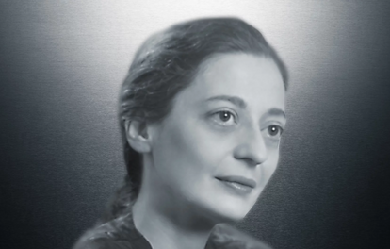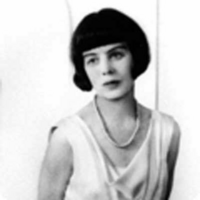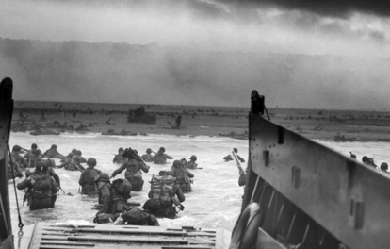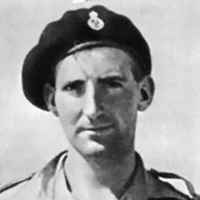
Helen Joy Davidman (18 April 1915 – 13 July 1960) was an American poet and writer. Often referred to as a child prodigy, she earned a master's degree from Columbia University in English literature at age twenty in 1935. For her book of poems, Letter to a Comrade, she won the Yale Series of Younger Poets Competition in 1938 and the Russell Loines Award for Poetry in 1939. She was the author of several books, including two novels.


Elizabeth Daryush (8 December 1887 – 7 April 1977) was an English poet. Life Daryush was the daughter of Robert Bridges; her maternal grandfather was Alfred Waterhouse. She married Ali Akbar Daryush, whom she had met when he was studying at the University of Oxford, and thereafter spent some time in Persia; most of her life was spent in Boars Hill, outside Oxford, where the Elizabeth Daryush Memorial Garden is named for her. Writings Poetry Daryush, daughter of English poet laureate Robert Bridges (some of her early work was published as 'Elizabeth Bridges’), followed her father’s lead not only in choosing poetry as her life’s work but also in the traditional style of poetry she chose to write. The themes of her work are often critical of the upper classes and the social injustice their privilege levied upon others. This characteristic was not present in her early work, including her first two books of poems, published under the name Elizabeth Bridges, which appeared while she was still in her twenties. According to John Finlay, writing in the Dictionary of Literary Biography, Daryush’s “early poetry is preoccupied with rather conventional subject matter and owes a great deal to the Edwardians.” Syllabic style Daryush took her father’s experiment in syllabic verse a step farther by making it less experimental; whereas Bridges’ syllable count excluded elidable syllables, producing some variation in the total number of pronounced syllables per line, Daryush’s was strictly aural, counting all syllables actually sounded when the poem was read aloud. It is for her successful experiments with syllabic meter that Daryush is best known to contemporary readers, as exampled in her poem Accentedal in the quaternion form. Yvor Winters, the poet and critic, considered Daryush more successful in writing syllabics than was her father, noting that her poem Still-Life was her finest syllabic experiment, and also a companion-piece to Children of Wealth. Winters considered the social context of Still Life, which is nowhere mentioned, yet from which the poem draws its power. Characteristics Beyond its social content, Daryush’s work is also recognized for a consistent and well-defined personal vision. As Finlay noted, "For her. . .poetry always dealt with the `stubborn fact’ of life as it is, and the only consolations it offered were those of understanding and a kind of half-Christian, half-stoical acceptance of the inevitable." However, he also argued that Daryush’s best poems transcend such fatalism, “dealing with the moral resources found in one’s own being. . .and a recognition of the beauties in the immediate, ordinary world around us.” In many of her terse short poems, there is formal and intellectual mastery; her last, longest and most amibitious poem, ‘Air and Variations,’ was a formal tribute to Gerard Manly Hopkins Daryush has been described as a pioneer technical innovator, a poet of the highest dedication and seriousness whose poetry grapples with life’s intensest issues.


Keith Castellain Douglas (24 January 1920– 9 June 1944) was an English poet noted for his war poetry during the Second World War and his wry memoir of the Western Desert campaign, Alamein to Zem Zem. He was killed in action during the invasion of Normandy. Poetry Douglas described his poetic style as “extrospective”; that is, he focused on external impressions rather than inner emotions. The result is a poetry which, according to his detractors, can be callous in the midst of war’s atrocities. For others, Douglas’s work is powerful and unsettling because its exact descriptions eschew egotism and shift the burden of emotion from the poet to the reader. His best poetry is generally considered to rank alongside the 20th century’s finest soldier-poetry. In his poem, “Desert Flowers” (1943), Douglas mentions World War I poet Isaac Rosenberg, claiming that he is only repeating what Rosenberg has already written. Early life Douglas was born in Tunbridge Wells, Kent, the son of Capt. Keith Sholto Douglas, MC (retired) and Marie Josephine Castellain. His mother became unwell and collapsed in 1924 of encephalitis lethargica, never to fully recover. By 1926, the chicken farm set up by his father had collapsed. Douglas was sent to a preparatory school (Edgeborough School in Guildford) the same year. The family became increasingly poor, and his father had to leave home in early 1928 to seek better employment in Wales. The persistent ill-health of Marie led to the collapse of the marriage of his parents by the end of that year, and his father remarried in 1930. Douglas was deeply hurt by his father not communicating with him after 1928, and when Capt. Douglas did write at last in 1938, Keith did not agree to meet him. In one of his letters written in 1940 Douglas looked back on his childhood: “I lived alone during the most fluid and formative years of my life, and during that time I lived on my imagination, which was so powerful as to persuade me that the things I imagined would come true.” Education Marie Douglas faced extreme financial distress, so much so that only the generosity of the Edgeborough headmaster Mr. James permitted Douglas to attend school in 1930–1931, his last year there. Douglas sat in 1931 for the entrance examination to Christ’s Hospital, where education was free and there was monetary assistance to cover all other costs. He was accepted, and joined Christ’s Hospital, near Horsham, in September 1931, studying there till 1938. It was at this school that his considerable poetic talent and artistic ability were recognised. So was his cavalier attitude to authority and property, which nearly led to expulsion in 1935 over a purloined training rifle. In surprising contrast, he excelled as a member of the school’s Officers Training Corps, particularly enjoying drill, although he was philosophically opposed to militarism. University After his bruising brush with authority in 1935, Douglas settled down to a less troubled and more productive period at school, during which he excelled both at studies and games, and at the end of which he won an open exhibition to Merton College, Oxford in 1938 to read History and English. The First World War-veteran and well-known poet Edmund Blunden was his tutor at Merton, and regarded his poetic talent highly. Blunden sent his poems to T. S. Eliot, the doyen of English poetry, who found Douglas’s verses 'impressive’. Douglas became the editor of Cherwell, and one of the poets anthologised in the collection Eight Oxford Poets (1941), although by the time that volume appeared he was already in the army. He does not seem to have been acquainted with somewhat junior but contemporary Oxford poets such as Sidney Keyes, Drummond Allison, John Heath-Stubbs and Philip Larkin, who would make names for themselves. At Oxford, Douglas entered a relationship with a sophisticated Chinese student named Yingcheng, or Betty Sze, the daughter of a diplomat. Her own sentiments towards him were less intense, and she refused to marry him. Yingcheng remained the unrequited love of Douglas’s life and the source of his best romantic verse, despite his involvements with other women later, most notably Milena Guiterrez Penya. Military service Within days of the declaration of war he reported to an army recruiting centre with the intention of joining a cavalry regiment, but like many others keen to serve he had to wait, and it was not until July 1940 that he started his training. On 1 February 1941 he passed out from the Royal Military College, Sandhurst, the British Army training academy for officers, and was commissioned into the 2nd Derbyshire Yeomanry at Ripon. He was posted to the Middle East in July 1941 and transferred to the Nottinghamshire (Sherwood Rangers) Yeomanry. Posted initially at Cairo and Palestine, he found himself stuck at Headquarters twenty miles behind El Alamein as a camouflage officer as the Second Battle of El Alamein began. At dawn on 24 October 1942, the Regiment advanced, and suffered numerous casualties from enemy anti-tank guns. Chafing at inactivity, Douglas took off against orders on 27 October, drove to the Regimental HQ in a truck, and reported to the C.O., Colonel E. O. Kellett, lying that he had been instructed to go to the front (luckily this escapade did not land him in serious trouble; in a reprise of 1935, Douglas got off with an apology). Desperately needing officer replacements, the Colonel posted him to A Squadron, and gave him the opportunity to take part as a fighting tanker in the Eighth Army’s victorious sweep through North Africa vividly recounted in his memoir Alamein to Zem Zem, illustrated with his own drawings. Death Captain Douglas returned from North Africa to England in December 1943 and took part in the D-Day invasion of Normandy on 6 June 1944. He was killed by enemy mortar fire on 9 June, while his regiment was advancing from Bayeux. Captain Leslie Skinner (regimental chaplain) buried him by a hedge, close to where he had died on "forward slopes point 102". Shortly after the war his remains were reburied at Tilly-sur-Seulles War Cemetery (14 km south of Bayeux) in plot 1, row E, grave number 2. Bibliography * Selected Poems (Keith Douglas, J.C. Hall, Norman Nicholson) (1943) * Alamein to Zem Zem (1946), reprinted 1966 * Collected Poems (Editions Poetry London 1951), reprinted 1966 * Selected Poems (Faber 1964) * The Complete Poems (Faber & Faber 1978), reprinted in 1987, 1997, 2011 * Alldritt, Keith. Modernism in the Second World War ISBN 0-8204-0865-4 * The Letters of Keith Douglas edited by Desmond Graham (Carcanet Press, 2000) ISBN 978 1 857544 77 0 Biography * Keith Douglas, 1920–1944 by Desmond Graham (OUP, 1974) ISBN 0-19-211716-5 References Wikipedia—https://en.wikipedia.org/wiki/Keith_Douglas


